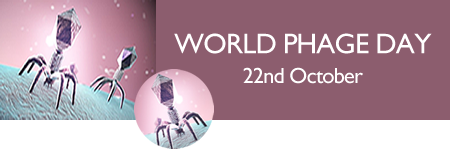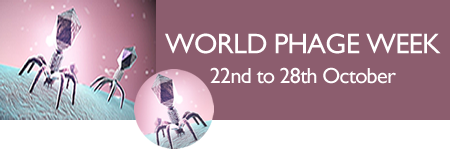Deadly drug-resistant infections are an increasing threat as our antimicrobial medicines fail to protect us. Personal stories convey both the fear, heartbreak and loss as well as accounts of extraordinary resilience and triumph over adversity. If you have any drug-resistance infection personal stories that you'd like to share, please email personalstory [at] AgeofthePhage.com.
PHAGE THERAPY SAVES LIFE OF A PATIENT AT A LONDON HOSPITAL
In London’s Great Ormond Street Hospital, two young teenagers were about to be discharged. Each had cystic fibrosis, a genetic condition that causes mucus to build up in the lungs. Recently, both had been fortunate enough to receive double-lung transplants, which can provide relief from some of the breathing problems associated with their condition. In the wake of their surgeries, the two teens got sick, and then sicker. The culprit: superbugs, bacteria that have evolved to become resistant to antibiotics.
As medical options dwindled, the doctors were forced to switch the patients’ treatment plans to in-home palliative care, which focuses on managing pain and discomfort. Essentially, they were being sent home to die. It was just before Christmas 2017. But there was still one longshot treatment possibility. The doctors knew of a researcher an ocean away at the University of Pittsburgh who might just hold the key to saving the teenagers’ lives.
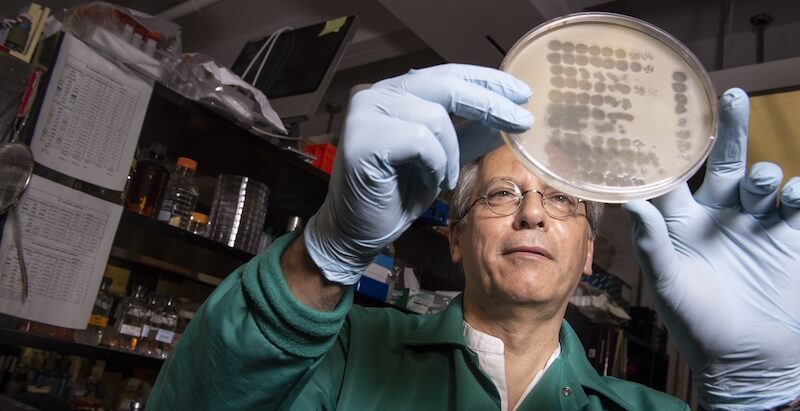
Graham Hatfull and his team at Pitt study phages—viruses that stalk bacteria. They didn’t expect that they would be asked to use those viruses in an unprecedented attempt to save the lives of two young patients on the other side of the Atlantic Ocean. Graham Hatfull, Pitt’s Eberly Family Professor of Biotechnology, is a phage expert. Most people haven’t heard of phages, short for bacteriophages, but there are approximately 10 million trillion trillion of them, or about 10 million more than there are stars in the universe.
Graham Hatfull, Pitt’s Eberly Family Professor of Biotechnology, is a phage expert. Most people haven’t heard of phages, short for bacteriophages, but there are approximately 10 million trillion trillion of them, or about 10 million more than there are stars in the universe. “Phage particles are the majority of all biological stuff on the planet,” Hatfull says.
\Under an electron microscope, they look like lunar landers crossed with robot spiders. In essence, they are viruses that use bacteria to reproduce. Some phages, known as virulent phages, hijack a bacterial cell’s machinery to create copies of themselves. They then multiply inside bacteria until there are so many that they burst out like candy from a smacked piñata. The bacteria die as a result, and each new phage goes on the prowl for more hosts in which it can repeat the process. It’s fitting that “phage” comes from the Greek word phágos, “a thing that devours.”
The London doctors wondered whether Hatfull knew of phages that could combat the bacteria infecting their patients... Read the rest of this amazing story of loss and success in the Fall 2019 edition of Pitt Magazine. https://www.pittmag.pitt.edu/news/phage-hunters. Written by Jason Bittel Photography by Aimee Obidzinski/Pitt Visual Services
Below: Graham Hatfull meets with patient Isabelle, her mother, Jo (right), and Helen Spencer (left), Isabelle's respiratory pediatrician at Great Ormond Street Hospital in London.
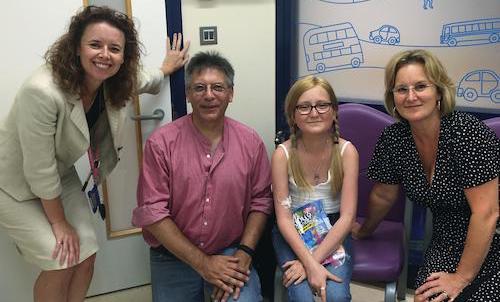
>You become desperate': Obscure therapy saves woman's life
Published on 2 Apr 2013.KomoNews.com.
https://youtu.be/ECoB4R7a5Ew
Seattle resident, Rachel George, has a persistent infection defeated by using bacteriophages bringing hope to her and her family. Once again a successful phage treatment from the Eliava Institute of Bacteriophages in the Republic of Georgia. Includes an interviews with a researcher at the Evergreen State College who works with Bacteriophages. Learn more about phage at: http://blogs.evergreen.edu/phage
>Killer Cure - Video about Phage Therapy, Georgia
Video about George Eliava institute of Bacteriophages, Tbilisi, Republic of Georgia
Published September 30, 2009. https://youtu.be/mrBSZaHuyTI
A former US Sheriff, after sustaining an knee injury suffered a debilitating staphylococcus infection for many years with antibiotics failing to cure the infection. Steve decided to be treated in Georgia at the Eliava Institute of Bacteriophages, Microbiology and Virology- a research institution under the Ministry of Science and Education of Georgia which studies bacteriophages and phage therapy. He left Tbilisi cured!
PATIENT SURVIVAL INITIATES THE FIRST PHAGE THERAPY CENTRE IN THE US
The first known person in the United States to successfully undergo intravenous bacteriophage (phage) therapy was Tom Patterson, PhD , professor of psychiatry at UC San Diego School of Medicine. He had contracted a life-threatening infection with a multidrug-resistant strain of Acinetobacter baumannii, an opportunistic and often deadly bacteria, while vacationing in Egypt in November 2015. Patterson was eventually transported to UC San Diego Health where, with emergency approval from the Food and Drug Administration (FDA), he was treated intravenously with an experimental phage cocktail that specifically targeted A. baumannii. He began improving almost immediately, emerging from a months-long coma.
Patterson's experience opened a fresh avenue of research aimed at finding alternatives to traditional antibiotics, amidst the growing problem of antimicrobial resistance. In an effort led by Patterson's wife, Steffanie Strathdee, PhD, Associate Dean of Global Health Sciences at UC San Diego School of Medicine, and Robert "Chip" Schooley, MD, professor of medicine and an infectious disease specialist at UC San Diego Health, five patients at UC San Diego Health have now been treated with phages. One of these patients had a years-long chronic infection that was successfully cleared, allowing him to undergo life-saving heart transplant surgery. In all cases, the phage treatments were considered experimental and required emergency approval by the FDA.
In June 2018, to further advance this work, UC San Diego School of Medicine launched the interdisciplinary Center for Innovative Phage Applications and Therapeutics (IPATH) with a three-year, $1.2 million grant from UC San Diego Chancellor Pradeep Khosla. Co-directed by Strathdee and Schooley, it is the first such Center in North America.
Learn more about Bacteriophage Therapy at UC San Diego Health:
https://health.ucsd.edu/news/topics/phage-therapy/Pages/default.aspx
https://health.ucsd.edu/news/topics/phage-therapy/Pages/Phage-101.aspx
For the full story view the video and the Tedx Talk by Steffanie Strathdee, PhD below.
Phage Treatment Saves A Life
25 April 2017. UC San Diego Health
Scientists and physicians at University of California San Diego School of Medicine, working with colleagues at the U.S. Navy Medical Research Center (NMRC), Texas A&M University, a San Diego-based biotech and elsewhere, have successfully used an experimental therapy involving bacteriophages.
Bacteriophages are viruses that target and consume specific strains of bacteria to treat a patient near death from a multidrug-resistant bacterium.
Video: How Sewage Saved My Husband's Life from a Superbug - Steffanie Strathdee | TEDxNashville
Published on 17 Oct 2017.
https://www.youtube.com/watch?v=AbAZU8FqzX4
Strathdee was recently credited with saving her husband's life from a deadly superbug infection using bacteriophages –viruses that attack bacteria. The case, which involved cooperation from three universities, the U.S. Navy and researchers across the globe, shows how phage therapy is a future weapon against multi-drug resistant bacterial infections which are expected to kill 10 million people per year by 2050.
PRANAV'S STORY
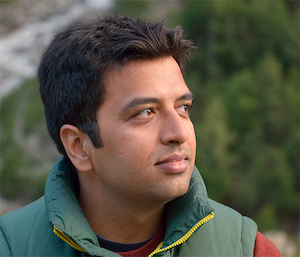
"Chronic Bacterial Prostatis - I had never heard of this condition, and always assumed prostate problems to be something one deals with in old age."
In the summer of 2016 at the age of 33, I contracted a debilitating condition called Chronic Bacterial Prostatitis along with Chronic Epididymitis – inflammation of the prostate gland and the epididymis, usually caused by an infection. I had never heard of these conditions, and had always assumed prostate problems to be something one deals with in old age.
"I began to feel a sense of hopelessness - my symptoms showed no improvements, whether I was on antibiotics or off them".
I started antibiotic treatment, but through the course of the medicine, I realised that my condition was not improving at all. Since my symptoms were not getting any better, After repeat courses of a variety of antibiotics, my symptoms were only worsening. I started getting chills and shivers, and had to wear a sweater all day long, even though we were in the middle of a hot and humid Indian summer. I started getting pelvic pains. I also began to feel a persistent weakness and lack of energy all the time – where earlier I could get through the day after a hearty morning breakfast, I now needed to eat every 3-4 hours to keep my energy levels up. I started to feel the need of an afternoon nap to be able to get through the rest of the day, something I had never felt in my life till that point.
I decided to stop taking antibiotics altogether, and started researching for possible solutions on my own. It was difficult for me to accept that a problem that affects 8-10% of men had no solution, despite all the advances modern medicine had made. It seemed ridiculous to me that medical science could harvest whole organs from stem cells, but could not successfully treat a bacterial infection in the prostate gland!
Phage Therapy
Then, one day in September, I came across the words “bacteriophage therapy” in relation to treating bacterial infections. I had no idea what this therapy was, and searched for it online to get more information.
"Could phage therapy be the light at the end of this very long tunnel that I was going through?"
I learned that phage therapy is a treatment that was used to cure bacterial infections since it was discovered a hundred years ago. It was simple; in the way that nature has simple answers to complex problems. Bacteriophages are naturally occurring viruses that feed on bacteria – they are the solution that nature has devised to keep bacterial overgrowth in check. This was my Eureka moment! As I researched phage therapy further, the treatment seemed promising, and the science behind it seemed solid. Had I finally hit upon a plausible answer to my problem – could phage therapy be the light at the end of the tunnel?
Read the rest of this story of antibiotic resistance and what Pranav did next…. https://www.vitalisphagetherapy.com/my-story

